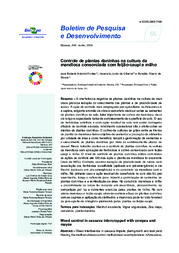Controle de plantas daninhas na cultura da mandioca consorciada com feijão-caupi e milho.
Controle de plantas daninhas na cultura da mandioca consorciada com feijão-caupi e milho.
Author(s): FONTES, J. R. A.; OLIVEIRA, I. J. de; MORAIS, R. R. de
Summary: Resumo: A interferência negativa de plantas daninhas na cultura da mandioca provoca redução do crescimento das plantas e de produtividade de raízes. A ação de controle mais empregada por agricultores no Amazonas é a capina, exigente em mão de obra e sem efeito residual sobre as sementes de plantas daninhas no solo, fator importante na cultura da mandioca, de ciclo longo e capacidade baixa de sombreamento da superfície do solo. O uso de herbicidas seletivos e com ação residual no solo tem como vantagens eficácia de controle elevada, rendimento operacional alto e efeito sobre sementes de plantas daninhas. O cultivo de culturas de grãos entre as fileiras de plantio de mandioca tem o objetivo de aumentar a produção de alimentos por unidade de área e como benefício reduzir a germinação de sementes e o crescimento de plantas daninhas por meio do sombreamento abaixo do dossel. Neste trabalho avaliou-se o controle de plantas daninhas na cultura da mandioca com aplicação de herbicidas e cultivo consorciado com feijão-caupi e milho. Weed control in cassava intercropped with cowpea and mayze: Weed interference in cassava impairs plant growth and root yield. Hoeing, the method of weed control method most used by farmers in Amazonas, is labor intensive and has no residual effect on soil seedbank, an undesirable aspect in cassava, a crop with long life cycle and low ability to shade soil surface and weeds. The use of selective herbicides has the advantages of high control efficiency, less labor-intensive and effect on weed seeds in soil (preemergence herbicides). Intercropping increases food production per unit area and contributes to weed control by reducing seed germination and weed growth through shading below the crop canopy. In this study we evaluated weed control in cassava with herbicides and intercropping with cowpea and corn. The weed control obtained with all control methods up to 100 days after cassava planting was excellent. However, the root yield was reduced with the association of isoxaflutole (applied preemergence) and clethodim (applied post-emergence) and in the cassava-corn intercropping. In the first, the isoxaflutole residual effect on soil was not long enough to prevent weed seed germination and reinfestation.
Publication year: 2024
Types of publication: Booklets
Unit: Embrapa Western Amazon
Observation
Some of Embrapa's publications are published as ePub files. To read them, use or download one of the following free software options to your computer or mobile device. Android: Google Play Books; IOS: iBooks; Windows and Linux: Calibre.
Access other publications
Access the Agricultural Research Database (BDPA) to consult Embrapa's full library collection and records.
Visit Embrapa Bookstore to purchase books and other publications sold by Embrapa.

